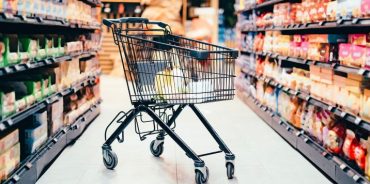Why harnessing the power of data science will transform retail media
We’ve extensively discussed how the grocery retail market is shifting, with consumers increasingly shopping online, placing a greater emphasis on insights. Data science can help grocery retailers better understand their target consumers and purchasing habits, helping drive business decisions and boost revenues in increasingly competitive markets.
The grocery retail market has a market size of more than US$11.6 trillion globally, capturing almost every individual on Earth, but shifts in consumer habits triggered by the pandemic mean that more people are shopping online. Pre-Covid, around 80% of consumer spending was done in-store. Now, about 40% of consumers are buying some of their goods online.
These changing times call for a different business approach. Harnessing the power of data science can help grocery retailers shift their business models to meet the changing demands of consumers. And this evolution in consumer behaviour has dramatically shifted the advertising landscape, with multiple digital touchpoints providing an opportunity for grocer retailers to target and engage with consumers.
While some consumers are returning to traditional bricks-and-mortar stores, there is no question that the most successful grocery retailers will be able to capture consumers both in-store and online.
The growth of retail media
Retail media is now the third biggest advertising discipline, and retail media spend is expected to grow by 66%, reaching US$100 billion in 2023. This has largely been driven by increased pressure on retailers’ finances, combined with the realisation that they sit on a wealth of first party data, which will only become more valuable with the end of third party cookies. By using first-party data, retailers can see which consumers purchase an item after seeing an ad. Retail media can also come from non-endemic brands, those that want to target similar retail audiences for their campaign.
Digital advertising, both onsite (on the retailer’s own website) and offsite (on other channels, such as social media platforms), can help customers discover new and relevant products while browsing the web, and in turn, boost grocery retailer sales by reaching more potential customers.
The role of data science
Successful retail media all starts with a deep understanding of your customer and reaching target customers at the right time through the right channels. The grocery retail market captures vast consumer data that can be used to refine marketing efforts and retargeting strategies.
Data science enables grocery retailers to better understand consumer habits and market trends, and then react accordingly, optimising sales and maximising revenues. It can also be used to measure and optimise returns. This efficient use of data empowers decision markers, driving authoritative-led decisions, thereby, helping them score high on predictability. Experienced data scientists can help harness the power of this data by using the correct tools and algorithms. For example, techniques such as logistic regression can help predict customer behaviour in the future and therefore drive business decisions.
Data science is the key enabler for grocer retailers throughout the retail media value chain. When grocery retailers understand their customers’ behaviour, they can accurately predict and meet their needs.
Understanding customer insights
Understanding and correctly interpreting customer data helps grocery retailers to understand their key challenges, performance drivers, and growth opportunities to drive measurable and sustainable returns. For example, data science can help a grocery retailer correctly understand the size of an opportunity, who their shoppers are, their buying patterns, and preferences. A retailer can also see which stores are doing well and where opportunities lie to drive more growth to maximise success. This deep understanding of audience segments can all lead to sustainable shopper growth.
Omnichannel marketing – creating a consistent brand message across multiple digital touchpoints – can ensure grocery retailers cast their net wide to reach as many new audiences as possible. By using real-world purchasing data to drive hyper-targeted campaigns, grocery retailers can target predictive audiences that align with their goals, eliminating the risk of reaching out to customers that are unlikely to engage, helping to maximise return on investment.
Personalised experiences
By harnessing the power of personalised experiences with an omnichannel approach throughout the customer journey, grocery retailers can target potential customers, from browsing the web to intent to purchase. Personalised experiences can be developed through several approaches. For example, by looking at the past, grocery retailers can group potential consumers by demographics such as age, affluence or past shopping habits, which can be used to predict future consumer actions. Alternatively, an approach that looks to the future can be harnessed by classifying consumers based on their propensity to take specific actions.
Using relevant features and advance machine learning, algorithms can generate a relevancy score for each customer’s propensity to buy, helping grocery retailers to predict what customers want and when. This data can be used to understand consumers’ purchasing cycle, for example, how often their purchase frequency is, how many units they typically buy, and their average spend.
This can help marketers ensure they deliver personalised content to relevant customers across the right digital channels and that retailers deliver the most relevant reward offers to help drive traffic and sales. Data science can also be harnessed to identify customers who may be potential customers for other products, driving acquisition.
Recommendation systems
Recommender systems can further help customers purchase the most suitable products. These intuitive systems use predictive data science to make product recommendations that are tailored to shoppers’ individual needs across the entire retail journey.
Recommender systems can help the customer’s path to purchase or increase engagement by matching recommendations at different touchpoints of the consumer shopping journey. For example, if a consumer usually buys coffee with each online order, a recommender system will remind them if they have not added it to their online basket.
There are several recommender systems, including content-based systems and collaborative filtering methods. Content-based systems use an individual’s historical information to inform future product choices, while collaborative filtering methods rely on the user-item interaction and the fact that similar users are likely to like similar products.
Measuring impact
Measuring impact is vital for advertisers. Consistent and centralised performance measurement is the key to optimising programmes based on real-world data. By understanding the impact of campaigns across all media channels, retailers can fine-tune their strategies to increase return on ad spend of advertising channels while also providing customers with a better-quality media offering. To do this effectively, retailers must clearly define key performance indicators, such as awareness, engagement, and conversion.
Finally, retailers must evaluate how retail media investments had an impact on in-store activity. For example, did it help expand product distribution? Did it help gain incremental merchandising? And did it strengthen relationships with key stakeholders?
Retail media is gaining momentum in the wider advertising industry, and there will be a lot of discussion in the coming weeks and months about the most effective way to engage with the channels that it offers. But one thing is certain: whether you’re a retailer or a CPG, maximising use of cutting-edge customer data science techniques will form the foundation of any successful retail media activity.
dunnhumby is a global customer data science company that helps grocery retailers perfect the science of eCommerce and retail media. We help grocer retailers drive sustainable growth through the intelligent use of customer data science.
Want to know more about the power of data science in grocery retail media? Click here to watch Shaveta discuss this in more detail.
TOPICS
RELATED PRODUCTS
The latest insights from our experts around the world




